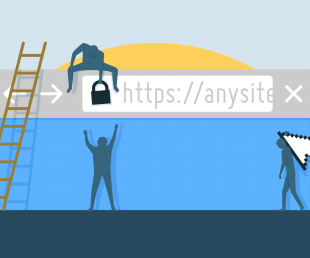Freelancers, the self-employed, and salespeople have one thing in common: They struggle to budget given their fluctuating, and sometimes unpredictable, incomes.
Imagine planning your monthly spending plan without a) knowing how much you’ll earn, b) knowing when you’ll get paid, and c) knowing how much you’ll make the following month. As crazy as it seems, this is a common scenario for people who are self-employed or working for commission.
Depending on the month and their sales or workload, they could absolutely kill it, just do okay, or fall flat on their faces in a moment of destitute failure. And the best part is, those with a fluctuating income almost never know what type of month it will be until the bitter end (e.g. when it’s too late to do anything about it or adjust your spending).
As a freelancer who enjoys this lifestyle, I’ve been riding the wave of a fluctuating income since 2012. And even though my income can double or crash at the drop of a hat, I rarely get stressed and I now save more money than I have at any other time in my life.
Budgeting With an Irregular Income: Ten Key Strategies
The thing is, there’s a method to my madness. While budgeting for a fluctuating income isn’t rocket science, certain strategies can improve your chance of success immeasurably. Through trial and error, I’ve found a process that helps take the sting out of the low months while also paving the way for optimal money management.
Here are the rules I follow when budgeting our family expenses on a wildly variable income:
Step 1: Know your baseline.
First things first: Before you can create a budget on a fluctuating income, you need to know your baseline – a.k.a. your bare-bones budget. Above all else, you need to know the bare minimum expenses you need to cover on a monthly basis.
For most people, this budget is comprised of expenses related to the absolute essentials – housing (rent or mortgage), utility bills, transportation, groceries, and childcare.
When following this plan, it’s crucial to know what you absolutely need to earn to pay your bills and get by. Fortunately, this step won’t take much work or effort on your part. To create your bare-bones budget, just break out a pen and paper and create a list of your essential, ongoing monthly expenses.
While fixed expenses like your rent or mortgage are easy to figure, you may need to estimate ongoing expenses that fluctuate. Think utility bills, gas for your commute, and groceries. And don’t forget to include savings, investments, and debt repayments in your bare-bones budget. Even though these bills may not be essential to your survival, they’re still important!
Step 2: Calculate monthly discretionary expenses.
Once you’ve created your bare-bones budget, you need to come up with a list that covers everything else. In your list of discretionary expenses, you should account for things like your cable television bill, any money you regularly spend on entertainment, cash for sports or hobbies, and money you spend dining out.
If you’re struggling to find your average spending on unnecessary stuff, break out your last few months’ of bank statements and credit card bills to take a look. Unfortunately, this step can be rather painful.
Sometimes, taking a cold, hard look at spending from previous month’s expenses is all it takes to discover huge, painful leaks in your spending. If you don’t like what you see, now is the perfect time to put yourself on spending diet and whittle those numbers down.
Step 3: Build your emergency fund.
If you already have some savings, you’re way ahead of the game. Most experts suggest keeping three to six months of expenses on hand, which will work in this case. Unfortunately, building savings when you have none can be difficult.
To come up with a plan, consider automatically socking away a certain percentage of your paycheck each week or month, selling stuff you don’t need, and allocating all “found money” (like a tax refund) straight into your savings account.
You’ll understand why this is so important in a minute, but suffice it to say that the key to living stress-free on a fluctuating income is having ample savings. Bad months will come along, and when they do, your savings will be there to fill in the gaps and keep you on track.
Step 4: Live on last month’s income.
Once you’ve created your bare-bones budget and added up your unnecessary expenses, you’ll know exactly how much money you need to make it through the month without dipping into savings. So, on the first of the next month that comes along, deposit that amount of money into your regular checking account – and nothing else.
From now on, you’ll deposit all of your income into whatever long-term or short-term savings account suits your fancy. (If you don’t have a checking or savings account, now is the time to open one!)
This whole “living on last month’s income” thing is what’s commonly referred to as a “zero-sum budget.” The idea is this: By living off last month’s income, you’re budgeting your month based on realistic figures – not income projections or wishful thinking.
Step 5: Pay yourself a salary.
Remember how I asked you to deposit what you need to live in your regular checking account on the first of the month (your bare bones budget + discretionary spending)?
That’s the same thing as paying yourself a salary, which is pretty darn amazing if you think about it. Where you were once struggling with a fluctuating income, you’re now paying yourself a steady wage on the first of every month.
Even better, this strategy can help you save more money! Where any income overages you had in the past might have been absorbed by unplanned spending, surplus income should theoretically start piling up in your savings account from here on out.
If it’s not, and your money is still draining instead, you’ll need to drastically rethink your bare bones budget and discretionary spending plan. Why? Because you’re spending more than you’re earning! It’s as simple as that.
Step 6: Pay your bills based on your zero-sum budget.
At the first of the month, you should theoretically have:
•the amount of money you need for bare-bones bills plus unnecessary spending in your checking account, and
•a zero-sum budget (spending plan) with your monthly expenses and bills listed.
Meanwhile, you’ll have been depositing your earnings into your regular savings account all along – not your checking account!
From here, you’ll pay your monthly bills according to the plan you designed, and that includes “paying your savings” and any debt repayments. If you want a separate savings account for these long-term savings, now is an excellent time to open one. Or you can simply allocate cash back to your regular savings account each month and watch the money pile up.
While some fancier folks use zero-sum budgeting software like You Need a Budget or create their own spreadsheet, you can accomplish something similar with a plain ol’ pen and paper.
I’ve been using a zero-sum budget for years now, and I still write mine out like it’s 1995. Whatever works, right? At the end of the day, it doesn’t matter as long as you get the job done and meet your goals.
Step 7: Mark bills as paid and end with ‘zero’.
Since all of your bills won’t be due or payable at the beginning of the month, you’ll need a system that allows you to keep track and monitor your spending as the month ticks by.
Here’s what I do: I pay bills twice per month — at the very beginning and around the 15th.
At the beginning of the month, I pay everything I that is due or payable ahead of time – my mortgage and any bills due in the middle of the month. Then, around the 15th, I pay all bills that trickled in during the first few weeks, yet are due by the end of the month – our Internet bill, utility bills, etc.
Since you’ve estimated some expenses like groceries or entertainment, you’ll need to monitor spending in those categories to make sure you don’t go over. By the end of the month, you should have a zero-sum budget with all bills marked paid, all your projected expenses (groceries, gas for your car, etc.) bought and paid for, and very little money leftover in your account.
Remember, the goal is getting down to “zero” each month.
Step 8: Start the entire process over again.
If you followed my plan, you should have:
•paid yourself a salary based on your expenses on the first of the month,
•put all of your earnings into savings,
•paid your bills according to your zero-sum budget,
•paid your savings and debt repayments, and
•finished the month with all bills paid and almost nothing in your checking account.
Now that that’s behind you, it’s time to start the whole process again! In theory, putting your income into savings and paying yourself a salary should take the stress and uncertainty out your bumpy and unpredictable income.
By paying yourself the same amount each month, you’ve allowed your good months to balance out the bad – but without the normal stress that comes with self-employment.
Step 9: Work out the kinks.
Learning to use a zero-sum budget isn’t rocket science, but that doesn’t mean it will be smooth sailing, either. Especially at first, you’ll likely need to tweak your estimated spending until you settle into a plan that works – at least most of the time.
If you haven’t lived with a budget before, it can be difficult to stick with the program. It might be hard to avoid impulse purchases, plan for biannual or irregular expenses like car insurance or home repairs, or tell yourself “no.”
At the end of the day, remember that it will all be worth it. Where you were once living with a fluctuating income, you’re now earning a salary, saving more than in the past, and doing it all on your own terms. That’s something worth celebrating!
Step 10: Find a place for your extra cash.
If you’re following all these steps to a T, you should have extra money left over each month. Not only are you saving money in your bare-bones budget, but your income overages should start piling up in your savings account.
While it’s smart to keep some of that money in an emergency fund, you may want to invest any substantial sums that build up. Remember, unless your savings account is paying a decent-sized interest rate, you’re losing money by letting too much cash sit idle.
Another way to put extra money to use is to speed up your journey out of debt. Figure out how much extra money you’re accumulating every few months and start putting those funds toward debt repayment in your zero-sum budget instead.
If you don’t want to do it on a monthly basis, you can also pay down debts in a lump sum every few months instead. Either way, you’ll put those funds to use, save money on interest, and get out of debt sooner than you planned.
Note: If you’re not accumulating any extra money, it may be time to rethink your bare-bones budget and discretionary spending categories. Because, if you aren’t saving anything, you’re simply spending every dollar you earn.
Final Thoughts
While a fluctuating income makes budgeting more of a chore, using a zero-sum budget and paying yourself a salary is the best way around it. Further, this strategy can actually help you become more in control of your money; by getting up close and personal with your spending, you might gain a new appreciation for the dollars you earn.
Personally, I’ve found that zero-sum budgeting helps me save more than I would otherwise. Thanks to my zero-sum budget, I am forced to look at my spending critically and pay my savings and investments as if they were an ordinary bills. And when I want to save more, I simply tighten my belt and look for expenses to cut out of the monthly spending plan I created.
I may not like it all the time, but I am always the one in control.



